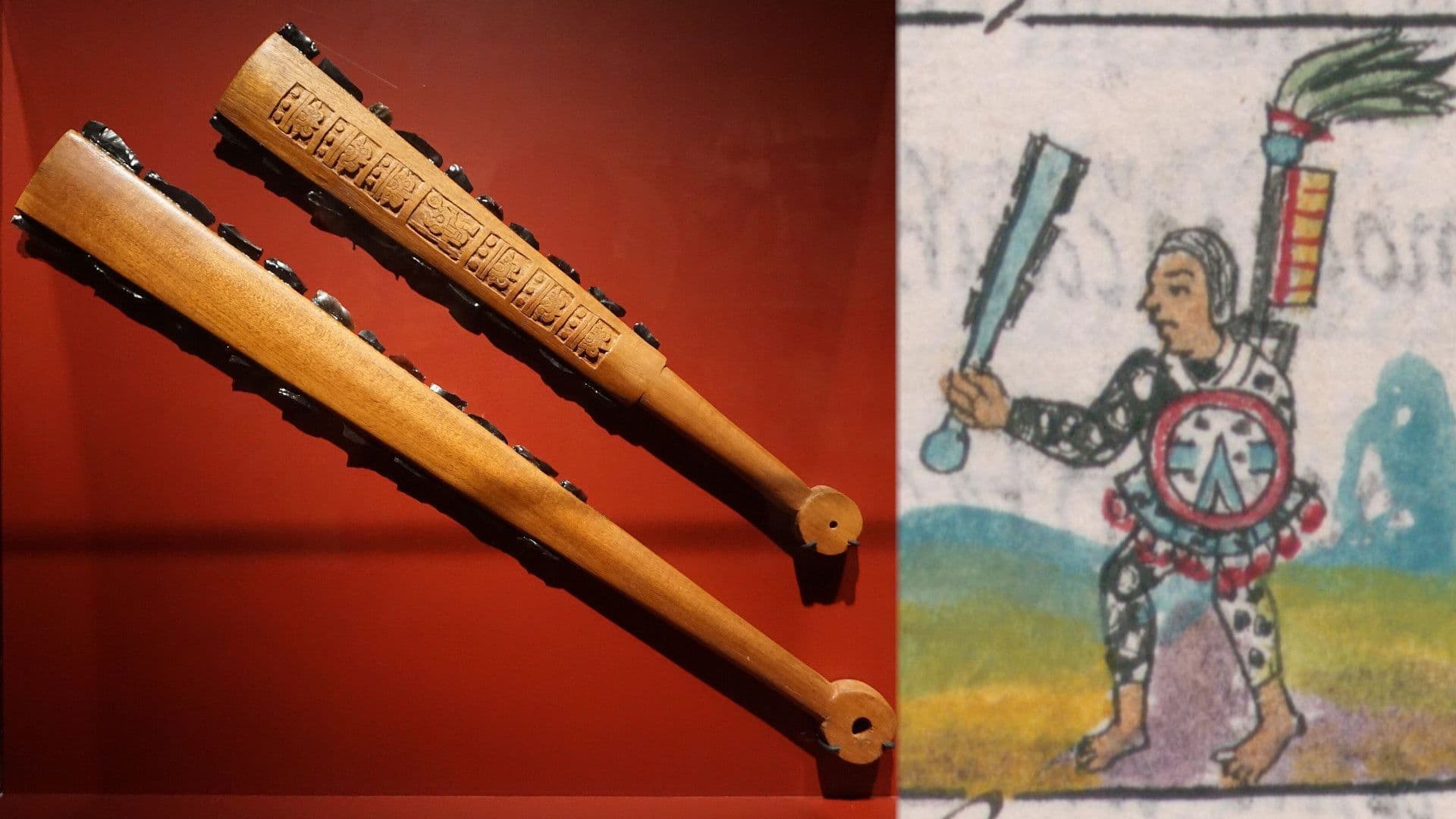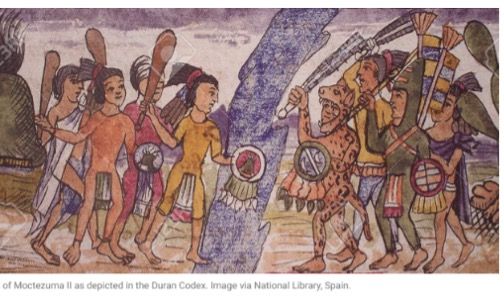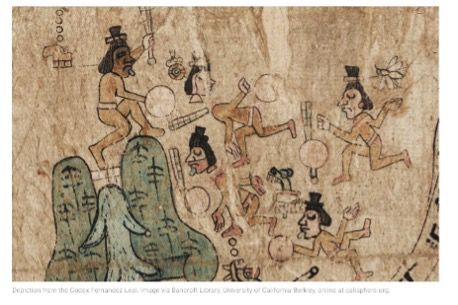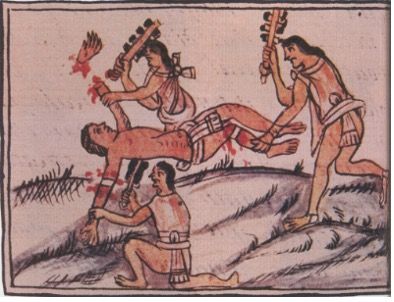KnoWhy #740 | July 9, 2024
What Kinds of Swords Did Book of Mormon Peoples Use?
Post contributed by
Scripture Central

“And now it came to pass that when the king had made an end of these sayings, and all the people were assembled together, they took their swords, and all the weapons which were used for the shedding of man’s blood, and they did bury them up deep in the earth.” Alma 24:17
The Know
The Book of Mormon mentions swords 156 times in both literal and figurative senses.1 Because the Book of Mormon is not available in its original language, its modern readers may envision a long, double-bladed metal weapon with a hilt, like those used by medieval European knights, when reading the English word sword. Such European-style metal swords have not been found in the ancient Americas, causing some critics to see Book of Mormon swords as an anachronism.2 However, weapons that are in many ways functionally equivalent to swords and that have been called swords historically and in academic literature were used throughout pre-Columbian America.3
The best candidate—among many—for Book of Mormon swords is probably something like the Aztec macuahuitl, also sometimes referred to more generally as a macana.4 It consisted of a flat stick of hard wood lined with obsidian or flint blades, positioned either in a straight or serrated fashion. These were referred to as swords (espadas) by the Spaniards and are still called swords by many modern scholars.5 Similarly, the Aztecs called the Spanish swords tepuzmacuauhuitl, meaning “metal macuahuitl.”6 Clearly, both of those cultures saw a similarity between the two weapons. The straight-bladed version of the macuahuitl is best known among the later Aztecs, but variations of the weapon can be traced back to early Book of Mormon times.7 Because these weapons broke down so rapidly, almost none survive today and so our knowledge must be gleaned primarily from inscriptions, artwork, and colonial accounts.8
Some have regarded these weapons as being more like clubs than swords.9 While some Mesoamerican weapons seem to be something between a sword and a club, Spanish accounts clearly distinguish between swords, or macuahuitls, and clubs, as does the artwork in codices.10 Furthermore, unlike clubs but like European swords, the Aztec macuahuitl had cutting ability. Mesoamerican codices show images of human heads and limbs being cut off by these weapons, and some Spanish accounts describe the decapitation of horses with them.11 This accords well with the Book of Mormon, which describes both arms and heads being sliced off by swords (see Alma 17:37–39; Ether 15:30–31).

The troops of Moctezuma II as depicted in the Duran Codex. Image via National Library, Spain.
Depiction from the Codex Fernandez Leal. Image via Bancroft Library, University of California Berkley, online at calisphere.org.

Florentine Codex ANNEX to Book II, f. 110v. Reproduced from Marco Antonio Cervera Obregon, “The Macuahuitl: An Innovative Weapon of the Late Post-Classic in Mesoamerica,” Arms and Armour 3, no. 2 (2006): 143.
In addition to the straight-bladed macuahuitl, several related Mesoamerican weapons of wood and stone existed that have been designated as swords, macanas, or macuahuitls by modern scholars but could also correspond to Book of Mormon scimitars and daggers, or even as axes, clubs, and other “weapons of every kind.”12 Some had only a sharp wooden blade without stone inserts, some a serrated stone edge, and others a smooth stone edge.13 These weapons variously had pointed tips, blades on both sides, and curved structures, and they varied in length.14

Left to right: A wooden sword from page 2 of Codex Mendoza. A weapon on a monument at La Nueva, reproduced from Matthew Roper, “‘To Inflict the Wounds of Death,’” 2016 FAIR Conference presentation, accessed June 18, 2024, online at https://www.fairlatterdaysaints.org/conference/august-2016/inflict-wounds-death A curved short sword, or potential scimitar, in the Mexican Codex Nuttall (Plate 76); reproduced from reproduced from Roper, “‘To Inflict the Wounds of Death’.” An Olmec macana with an axe-like shape from Monument 91 at San Lorenzo; see Evidence Central, “Book of Mormon Evidence: Swords in Book of Mormon Times,” Evidence #0194, May 25, 2021 and Evidence Central, “Book of Mormon Evidence: Axes,” Evidence #0170, March 22, 2021. The weapon from Uaxcatun stela 5; image courtesy of the Peabody Museum of Archaeology and Ethnology, https://peabody.harvard.edu/uaxactun. A serrated macuahuitl from the Historia Tolteca-Chichimeca; reproduced from Roper, “‘To Inflict the Wounds of Death’.” Atzec macuahuitl from the Florentine Codex; see Evidence Central, “Book of Mormon Evidence: Pre-Columbian Swords,” Evidence #0195, May 25, 2021. A smooth-bladed macuahuitl from page 12 of Codex Selden; courtesy of FAMSI, http://www.famsi.org/research/pohl/jpcodices/selden/scene_by_scene.htm. A weapon depicted on Mapa de Teozacualco; courtesy of the Mapas Project, https://mapas.wired-humanities.org/zoomify/33372. A sword from page 66 of the Borgia Codex; courtesy of FAMSI, http://www.famsi.org/research/loubat/Borgia/thumbs4.html. A sword from plate 44 of the Duran Codex; reproduced from Roper, “‘To Inflict the Wounds of Death’.”.
Identifying the Book of Mormon sword with the macuahuitl raises a few questions but also answers many others. For example, what might the word “hilt” refer to in Alma 44:12 and Ether 14:2 if we understand the swords to be macuahuitls? In this case, the hilt would simply refer to the unbladed portion of the weapon, and drawing a sword (like in Mosiah 19:4; Alma 1:9; 19:22; and 20:16) would mean raising it or pulling it from a bag, belt, or covering since sheaths did not seem to be used in the New World.15
One great strength of this identification is the Ammonites’ powerful concerns about stained swords (Alma 24:12–15). While this staining could simply be an idiom or figure of speech, wooden weapons literally absorb blood and become permanently stained unlike metal weapons, which can be easily wiped clean.16 At the same time, obsidian blades could give Book of Mormon swords the shiny brightness they are described as having.17
Certainly, the Book of Mormon asserts that some metal swords were used. However, only a small fraction of Book of Mormon swords are specifically said to be made of metal.18 The sword of Laban is explicitly said to be steel, which is archaeologically attested in the ancient Near East in Nephi’s era.19 The only other explicitly metal swords in the Book of Mormon are the steel swords made by Shule a few generations after the Jaredite migration from Mesopotamia to the New World. The early Jaredites were familiar with metal working, but it is not stated how many steel swords Shule (a great-grandson of Jared) made and whether they were an early anomaly or somehow remained the norm in Jaredite culture.20
Other passages hint at the possibility of other metal swords as well: for example, Nephi said that he made swords after the manner of Laban’s sword, weapon making is mentioned in conjunction with metallurgy several times, and Jaredite weapons whose blades were “cankered with rust” were discovered.21 Yet these statements can be interpreted in different ways. Nephi’s swords may have been stylistically modeled on Laban’s swords without being made of the same material. The mention of metallurgy and weaponry together only occurs a few times and could represent a limited and elite industry.22 Similarly, the discovery of Jaredite metal weaponry and armor was probably noted precisely because it was so rare. The difference in archaeological evidence between dozens of metal swords and several million metal swords would be astronomical and could help explain why metal swords have not yet been discovered in ancient America.23

An inscription of a warrior with a macuahuitl and double dagger from Loltun cave inscription. This double dagger is similar to the Old World haladie weapon. Sorenson, Mormon’s Codex, 412–414; Hamblin and Merrill, “Swords in the Book of Mormon,” 339; Roper, “Ancient Warfare” (forthcoming).
Many of the Book of Mormon weapons, including swords, daggers, and axes are also mentioned in the King James Version of the Old Testament. In the Old World, these weapons were indeed made with metal in many cases.24 However, we need not assume that Lehites or Jaredites continued to use Old World weaponry throughout their separate existences—these groups would likely have adapted to their new environments rapidly. John L. Sorenson asserts, “Their eventual encounters with warfare likely involved largely experimental or borrowed measures in the new land since the record lacks any indication that the immigrant generation brought firsthand knowledge of warfare with them.”25
It is also likely that the English weaponry words used in the Book of Mormon translation are linguistic approximations since modern English-speaking people had no exactly similar weaponry to the Nephites. The functions of Nephite weapons, however, were probably similar to what English speakers would call swords, though their shape and composition could have varied quite widely. Even modern definitions of swords vary, with some emphasizing the function, some the shape, and others the composition.26 One study of the worldwide history of swords uses the broad term “hilted cutting weapon” and notes that “the nomenclature of ancient weapons is a controversial area.”27
The Why
Three points can be raised in light of this information. First, if it is indeed the case that the Ammonites were using razor-sharp, flint-studded wooden weapons, then the symbolism of these weapons’ representing the Ammonites’ complete forgiveness becomes all the more vivid because of the permanence of bloodstains indelibly left on wooden weapons.28 Scripture teaches that Jesus is the only means through which our sins may be forgiven, and so the imagery of Jesus removing permanent stains is beautiful and powerful. The Ammonites, former killers and murderers, proved to be some of the most penitent and zealous believers.29 Like them, if we will bury the swords of our spiritual rebellion or outright transgressions, we can know that our words and deeds, our swords and souls, can be found spotless and bright at the last day.
Second, some readers of the Book of Mormon or Bible may be discouraged when unambiguous evidence has not yet surfaced for an aspect of Book of Mormon or biblical archaeology, but it is important to remember that true faith is not based upon material evidences. Neal A. Maxwell said,
All the scriptures, including the Book of Mormon, will remain in the realm of faith. Science will not be able to prove or disprove holy writ. However, enough plausible evidence will come forth to prevent scoffers from having a field day, but not enough to remove the requirement of faith. Believers must be patient during such unfolding.30
The search for metal swords in the New World presents just that sort of opportunity to exercise faith. Absence of evidence is not unconditional evidence of absence, and archaeological discoveries that overturn previous anthropological paradigms occur regularly. If we are willing to allow that most Book of Mormon swords may have resembled hilted, bladed weapons from pre-Columbian America, the difficulties disappear considerably. Many difficulties for modern readers may result from forcing available evidence to fit preconceived notions instead of allowing scripture and available evidence to speak for themselves.

A stela from Tonina (613 AD), shown in Matthew Roper, “‘To Inflict the Wounds of Death,’” 2016 FAIR Conference presentation, accessed June 18, 2024, online at https://www.fairlatterdaysaints.org/conference/august-2016/inflict-wounds-death.
Third, it pays rich dividends to look more closely at the Book of Mormon and our assumptions about what it says. All readers do well to let both archaeology and scripture speak their case and then, after considering all available sources of knowledge and truth, decide how to interpret worldly data and apply divine statements. In the present case, concluding that most Book of Mormon swords are well understood as being similar to a macuahuitl exemplifies a faithful way to affirm the historicity of scripture while reckoning with archaeological evidence.
Matthew Roper, “Anachronisms: Accidental Evidence in Book of Mormon Criticisms, Part 2: Ancient Warfare,” (forthcoming).
William J. Hamblin and A. Brent Merrill, “Swords in the Book of Mormon,” in Warfare in the Book of Mormon, ed. Stephen D. Ricks and William J. Hamblin (Provo, UT: Foundation for Ancient Research and Mormon Studies [FARMS]; Salt Lake City, UT: Deseret Book, 1990), 329–351.
Matthew Roper, “Swords and Cimeters in the Book of Mormon,” Journal of Book of Mormon Studies 8, no. 1 (1999): 34–43, 77–78.
John L. Sorenson, Mormon’s Codex: An Ancient American Book (Salt Lake City, UT: Deseret Book; Provo, UT: Neal A. Maxwell Institute for Religious Scholarship), 410–413.
John L. Sorenson, Images of Ancient America: Visualizing Book of Mormon Life (Provo, UT: FARMS, 1998), 130–132.
- 1. William J. Hamblin and A. Brent Merrill, “Swords in the Book of Mormon,” in Warfare in the Book of Mormon, ed. Stephen D. Ricks and William J. Hamblin (Provo, UT: Foundation for Ancient Research and Mormon Studies [FARMS]; Salt Lake City, UT: Deseret Book, 1990), 332.
- 2. Matthew Roper, “Anachronisms: Accidental Evidence in Book of Mormon Criticisms, Part 2: Ancient Warfare,” (forthcoming); Brent Lee Metcalfe, “Apologetic and Critical Assumptions about Book of Mormon Historicity,” Dialogue: A Journal of Mormon Thought 26, no. 3 (1993): 161.
- 3. Hamblin and Merrill, “Swords in the Book of Mormon,” 329–351; John L. Sorenson, Mormon’s Codex: An Ancient American Book (Salt Lake City, UT: Deseret Book; Provo, UT: Neal A. Maxwell Institute for Religious Scholarship), 410–414; Matthew Roper, “Swords and Cimeters in the Book of Mormon,” Journal of Book of Mormon Studies 8, no. 1 (1999): 34–43, 77–78; Evidence Central, “Book of Mormon Evidence: Pre-Columbian Swords,” Evidence #0195, May 25, 2021; Evidence Central, “Book of Mormon Evidence: Swords in Book of Mormon Times,” Evidence #0194, May 25, 2021; Roper, “Ancient Warfare.”
- 4. Sorenson, Mormon’s Codex, 411; Hamblin and Merrill, “Swords in the Book of Mormon,” 338–347. The Maya called the macuahuitl a hatzab, perhaps connected to the Hebrew hsb, meaning “to hew.” Sorenson, Mormon’s Codex, 411; Roper, “Ancient Warfare.”
- 5. Matthew Roper, “Eyewitness Descriptions of Mesoamerican Swords,” in Pressing Forward with the Book of Mormon: The FARMS Updates of the 1990s, ed. John W. Welch and Melvin J. Thorne (Provo, UT: FARMS, 1999), 169–176; Sorenson, Mormon’s Codex, 410; Ross Hassig, Aztec Warfare: Imperial Expansion and Political Control (Norman, OK: University of Oklahoma Press, 1988), 82–83.
- 6. Michael D. Coe, “Pre-Conquest America,” in Swords and Hilt Weapons (New York, NY: Weidenfeld and Nicholson, 1989), 222.
- 7. Evidence Central, “Swords in Book of Mormon Times”; Sorenson, Mormon’s Codex, 415; Coe, “Pre-Conquest America,” 220.
- 8. The most developed American cultures lived in tropical and subtropical climates, which accelerate deterioration of archaeological remains. Marco Antonio Cervera Obregon, “The Macuahuitl: An Innovative Weapon of the Late Post-Classic in Mesoamerica,” Arms and Armour 3, no. 2 (2006): 133, 137, says, “The fact that this weapon does not appear in any archaeological records so far recovered, in a good part of Mesoamerica before the Post-Classic, does not mean that it has not been used or at least not on such a grand scale as the lance or the átlatl were. … We know more about this Mexica weapon from written sources than from archaeology itself.” A recent study of stone shards postulates that many of the shards were used for macanas. Prudence M. Rice, “Macanas in the Postclassic Maya Lowlands? A Preliminary Look,” Lithic Technology 47, no. 4 (2022): 314–327.
- 9. James White, “Of Cities and Swords,” Christian Research Journal 19, no. 1 (1996): 35. There is admittedly some variation among scholars in the classification of the macuahuitl: Ross Hassig calls them swords, Michael Coe calls them sword-clubs, and Marco Antonio Cervera Obregon insists that they are unique from both swords and clubs. For variations in the definition of sword, see note 27. Coe, “Pre-Conquest America,” 220–222; Hassig, Aztec Warfare, 45; Obregon, “Macuahuitl,” 128.
- 10. Francisco López de Gómara, The Conquest of the Weast India (n.p.: Readex Microprint, 1966), 186; Antonio de Herrera, The General History of the Vast Continent and Islands of America [ . . .], 4 vols. (New York, NY: AMS Press, 1973), 2:352.
- 11. For a Spanish source describing decapitation by a macuahuitl, see Fray Diego Duran, The History of the Indies of New Spain, trans. Doris Heyden (Norman, OK: University of Oklahoma Press, 1994), 258; López de Gómara, Conquest of the Weast India, 187.
- 12. The multiplicity of terms suggests that the weapons differ somewhat, though perhaps they overlap to a degree in function or form. A scimitar slashes and cuts, a dagger stabs and thrusts, an axe and warclub can chop, hack, and hew, but a sword can do all of these. A small dagger could also simply be fashioned from an obsidian shard. See Evidence Central, “Book of Mormon Evidence: Cimeters,” Evidence #0097, September 19, 2020; Book of Mormon Central, “Why Does the Book of Mormon Mention Cimeters? (Mosiah 9:16),” KnoWhy 472 (October 2, 2018). Evidence Central, “Book of Mormon Evidence: Axes,” Evidence #0170, March 22, 2021. For projectile weaponry, see Book of Mormon Central, “What Does Archaeology Reveal about Warfare during Early Nephite Times? (Jarom 1:7–8),” KnoWhy 328 (June 19, 2017); Roper, “Ancient Warfare.”
- 13. For a discussion of wood-bladed swords, see Roper, “Ancient Warfare”; Coe, “Pre-Conquest America,” 218; Bernabe Cobo, Inca Religion and Customs, trans. Roland Hamilton (Austin, TX: University of Texas Press, 1990), 218; Steven A. LeBlanc, Prehistoric Warfare in the American Southwest (Salt Lake City, UT: University of Utah Press, 1999), 97–98, 104–106; David H. Dye, “The Transformation of Mississippian Warfare: Four Case Studies from the Mid-South,” The Archaeology of Warfare: Prehistories of Raiding and Conquest, ed. Elizabeth N. Arkush and Mark W. Allen (Gainesville, FL: University Press of Florida, 2006), 131.
- 14. The Loltun Cave macana has a pointed tip, which could help explain the sword tip mentioned in Alma 44:13. See Roper, “Swords and Cimeters in the Book of Mormon,”40–41; Sorenson, Mormon’s Codex, 411–412; Hamblin and Merrill, “Swords in the Book of Mormon,” 337–339, 341.
- 15. Roper, “Swords and Cimeters in the Book of Mormon,” 39–41; Hamblin and Merrill, “Swords in the Book of Mormon,” 337–338, 343–344.
- 16. Roper, “Swords and Cimeters in the Book of Mormon,” 39; Hamblin and Merrill, “Swords in the Book of Mormon,” 342–343; Book of Mormon Central, “What Is the Symbolism of the Stained Swords of the Anti-Nephi-Lehies? (Alma 24:12),” KnoWhy 132 (June 29, 2016). Sorenson, Mormon’s Codex, 412–413.
- 17. Alma 24:12–13, 15–16; Matthew Roper, “On Cynics and Swords,” FARMS Review of Books 9, no. 1 (1997): 152.
- 18. Jerry D. Grover Jr., The Swords of Shule: Jaredite Land Northward Chronology, Geography, and Culture in Mesoamerica (Provo, UT: Challex Scientific, 2018), 267–281; Sorenson, Mormon’s Codex, 331–344.
- 19. Book of Mormon Central, “What Was the Sword of Laban Like? (1 Nephi 4:9),” KnoWhy 401 (January 23, 2018).
- 20. Ether 3:1, 3; 7:9. The use of steel in the Book of Mormon has especially turned heads, as the term now commonly refers to carburized iron technology; however, the term originally meant simply to make something hard, and the word is used in the Old Testament as a mistranslation for bronze. Book of Mormon Central, “Why Did Nephi’s ‘Fine Steel’ Bow Break? (1 Nephi 16:18),” KnoWhy 548 (January 31, 2020); Grover, Swords of Shule, 267–281. Hamblin and Merrill, “Swords in the Book of Mormon,” 347, suggest that Shule’s steel swords could have been a translational anachronism made by Mosiah or Moroni, who would have been familiar with Laban’s steel sword.
- 21. 2 Nephi 5:14; Jarom 1:8; Mosiah 8:10–11.
- 22. Steel is mentioned in conjunction with weaponry only in Jarom 1:8. Metalworking with other metals is also mentioned alongside weapon making in 2 Nephi 5:14–15 and Ether 10:23–27, though perhaps coincidentally because these passages mention general industries of the people.
- 23. Despite a lack of evidence for metal swords in Book of Mormon times, arguments have been made that Mesoamerican metallurgy began much earlier than the current consensus or that South American metallurgy was imported. Metal was certainly used in ancient Mesoamerica, at least on a limited basis and for decorative purposes. Evidence Central, “Book of Mormon Evidence: Decorative Iron,” Evidence #0356, July 11, 2022; Evidence Central, “Book of Mormon Evidence: Olmec Iron,” Evidence #0035, September 19, 2020; Sorenson, Mormon’s Codex, 328–344; Matthew Roper, “Anachronisms: Accidental Evidence in Book of Mormon Criticisms, Part 3: Metals,” (forthcoming).
- 24. The Hebrew word hereb is most commonly translated “sword,” but also it is also rendered “dagger” in Judges 3:16, 21–22. Ludwig Koehler, Walter Baumgartner, and Johann J. Stamm, The Hebrew and Aramaic Lexicon of the Old Testament, ed. Mervyn E. J. Richardson, 2 vols. (Boston, MA: Brill, 2001), s.v. “חֶרֶב.” This source will hereafter be referred to as HALOT. Several Hebrew words are translated as “axe,” referring both to weapons (battle axe, mace, or warclub) and to various chopping and hewing tools (adze, pickaxe); HALOT, s.v. “מַפֵּץ“ ”,קַרְדֹּם“ ”,מַעֲצָד“ ”,גַּרְזֶן.” “Club” is not used in the King James Version, though “rod” and “staff” (Hebrew shebet and matteh) are sometimes mentioned as weapons. Hebrew shebet and matteh and a few other words are translated as “club” in other Bible versions. See HALOT, s.v. “תּוֹתָח“ ”,מַפֵּץ“ ”,מַפָּץ“ ”,שֵׁבֶט“ ”,מַטֶּה.” “Cimeter” is not used in the King James Version, though one of Goliath’s weapons in 1 Samuel 17:6, 45 was probably a scimitar. Evidence Central, “Cimeters”; Book of Mormon Central, “Why Does the Book of Mormon Mention Cimeters?”; Paul Y. Hoskisson, “Scimitars, Cimiters! We have Scimitars! Do We Need Another Cimiter?,” in Warfare in the Book of Mormon, 352–359; HALOT, s.v. “כִּידוֹן.”
- 25. Sorenson, Mormon’s Codex, 34; John L. Sorenson, Images of Ancient America: Visualizing Book of Mormon Life (Provo, UT: Foundation for Ancient Research and Mormon Studies, 1998), 130–132.
- 26. Definitions of sword vary in strictness and can focus on shape, material, or function. Webster’s 1828 dictionary defines it loosely based on its function as “an offensive weapon worn at the side, and used by hand either for thrusting or cutting.” The Oxford English Dictionary adds a description of shape, and popular understanding usually includes a metal composition. Noah Webster, An American Dictionary of the English Language (New York, NY: S. Converse, 1828), s.v. “sword;” Oxford English Dictionary, s.v. “sword,” https://oed.com/dictionary/sword_n?tab=meaning_and_use#19303158.
- 27. Victor Harris, introduction to Swords and Hilt Weapons, comp. Michael D. Coe et al. (New York, NY: Weidenfeld and Nicholson, 1989), 6; Anthony Harding, “Stone, Bronze, and Iron,” in Swords and Hilt Weapons, 8.
- 28. Roper, “Swords and Cimeters in the Book of Mormon,” 39; Hamblin and Merrill, “Swords in the Book of Mormon,” 342–343; Sorenson, Mormon’s Codex, 412–413; Book of Mormon Central, “What Is the Symbolism of the Stained Swords of the Anti-Nephi-Lehies?”
- 29. For a discussion of whether the Ammonites were pacifists, see Book of Mormon Central, “Why Did the Ammonites Covenant Not to Take Up Arms? (Alma 24:15),” KnoWhy 567 (June 30, 2020).
- 30. Neal A. Maxwell, Plain and Precious Things (Salt Lake City, UT: Deseret Book, 1983), 4; Matthew Roper, “Anachronisms: Accidental Evidence in Book of Mormon Criticisms, Introduction,” Interpreter: A Journal of Latter-day Saint Faith and Scholarship (forthcoming).